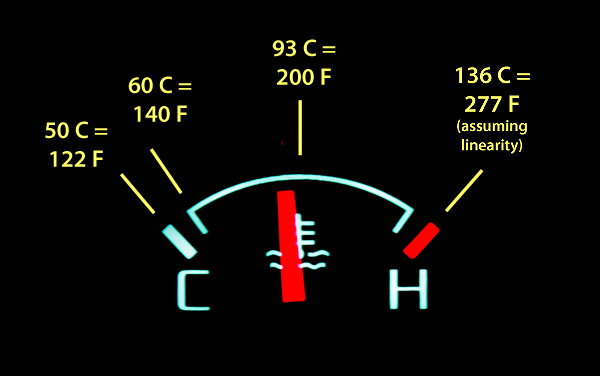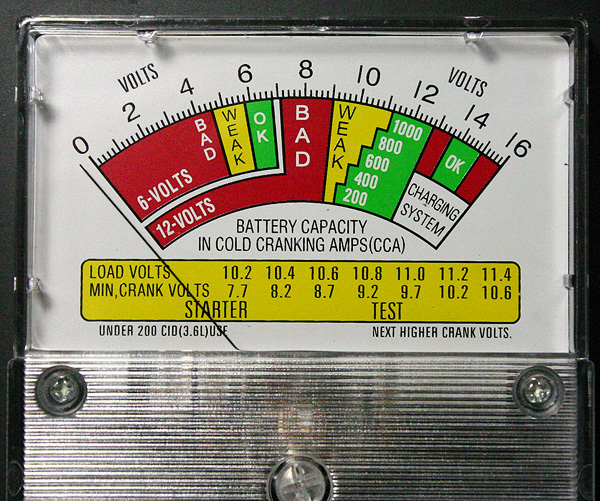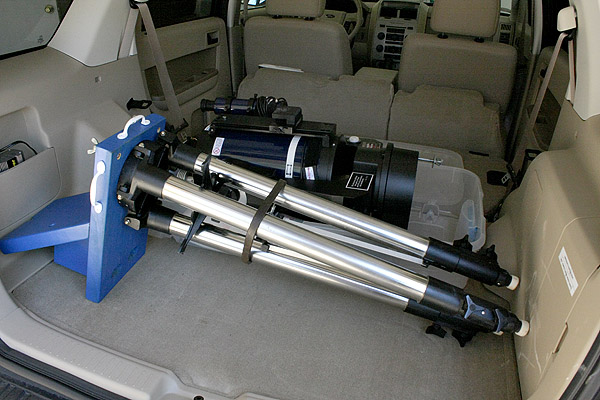 |
|
 |
2011
November
26-30
|
End of month
The week right after Thanksgiving Vacation is always very busy at the University,
so I'll close out the month now. But let me take up a suggestion Cathy made:
After "Black Friday" and "Cyber Monday" let's name the rest of the shopping days too,
so that we'll have a sort of secular Advent.
She suggests "Checkout Line Impulse Purchase Tuesday."
I suggest "Plastic Toy Wednesday" and "Out-Of-Season Sports Gear Thursday."
Continue the series if you dare...
It looks like America has totally forgotten that Christmas has anything to do with Jesus.
The purpose of Christmas nowadays is shopping!
Permanent link to this entry


|
2011
November
25
|
Jupiter

Here is one of my best pictures of Jupiter, taken last night (around 10:30 p.m. EST November 24)
with my 8-inch telescope. Jupiter was unusually high overhead and also unusually close to the earth.
No satellites or Great Red Spot in this picture, but you can see some dark spots and lots of
detail in the belts.
Permanent link to this entry
What is a fair tax system?
[Updated.]
I've recently been in several conversations about the American tax system.
Some people feel the rich aren't paying their fair share.
Others feel the working poor and lower middle class aren't paying their fair share.
Some believe we have both problems at the same time, so that the whole
burden falls on the middle class and upper middle class, exactly the people
who are opening up new opportunities for everyone all the time.
Almost a year ago I wrote
a series of blog entries
about this, and I don't plan to repeat them here.
But I do want to make a few points.
First, there is a long list of questions that should be asked of anyone
advocating (or even opposing) a change in tax policy. Among them:
(a) What do you want taxation to accomplish? Just to fund the government,
or also to change people's behavior and/or the distribution of wealth? Do you
want to skim money off the economy without disturbing it, or do you want to use
taxation as a bulldozer to move things around? How we evaluate tax policies will
depend on what we want them to accomplish.
(b) Related: Do you have a functioning market economy or do you need to break
up a feudal system? This applies mainly to other countries; the United States
has one of the most successful market economies the world has ever seen.
But we sometimes hear, applied to situations in America, Marxist rhetoric
that was originally aimed at breaking up systems consisting
of huge landowners and powerless serfs. Think carefully whether it's applicable.
(c) Related again: Do you know the wrong people are in power, or do
you just imagine it? Sorry to be so blunt, but I've heard people
say vague things about how "Wall Street ruined us all" that don't seem to be based
on real knowledge of actual events, just a search for an imaginary scapegoat.
(Not that there haven't been misdeeds, of course! But can't we put some of the
blame for the crash of 2008 — at least a little — on consumers who
borrowed money they knew they had no way to pay back?)
(d) By "fair share" are you talking about morality or practicality?
There are two aspects to any policy question. First, there are
empirical questions: what will actually happen
when a policy is implemented? Excessively high taxes reduce the incentive to work;
so does excessive leveling of outcomes. Excessively low taxes fail to fund the
government. Those are empirical facts separate from any principles of morality.
What is morally fair is harder to pin down. Obviously, tax systems should
not be capricious or treat different people differently for no good reason.
Taxes also should not be confiscatory; that is, heavy taxes should not be used to
deliberately eliminate activities or properties that are not illegal.
Or to put this another way, if a government wants to ban something, it should
come right out and say so, so that the ban can be debated, rather than backhandedly
taxing something to death.
Some rich people believe their "fair share" of taxes is the same fraction of their
income as a poor person's. That is, if a poor person pays 10% income tax, a rich
person should also pay 10% income tax. Most of us disagree with this; we observe
that higher tax rates create less hardship on the rich than on the poor (which is
mostly an empirical observation, not a moral one). We feel that fairness might be
expressed as equal hardship, not equal percentage of income. You admit already
that taxes should be a percentage of income, not a flat amount of money. Make it
a percentage of disposable income.
And then we get back to the empirical question — if we raised tax rates on
the rich, would it actually cut incentive? In fact, as I understand it, our tax
rates are flatter now than they have been at most times in history. When John F.
Kennedy pointed out that cutting taxes could raise government revenue, the top
income tax rate on the rich was 91%. It is now 35% (and was even lower from 1988
to 1993). It is hard to claim that the present 35% rate is hindering incentive
when much higher rates apparently did not stall the economy.
For that matter, is income the right thing to tax? Although the transition
from income tax to a national sales tax is hard to make — especially penalizing
people who have saved post-tax dollars for retirement — the appeal of a sales
tax is that the best place to catch money is where it's being spent.
From here I refer you to the series I wrote last December, except for just one more thing.
Back then I discussed a mathematical model of income from scalable professions,
i.e., activities where the same work generates more income if there is a larger
audience or a larger amount of some capital resource. Examples are entertainers and
investment managers.
I thought of a clearer, simpler way to explain the model. Consider
income from work vs. income from luck. Suppose gambling were entirely legal and there
were no moral objections to it. (Maybe imagine the Publishers Clearing House Sweepstakes,
which randomly bestows money on people who haven't even placed bets.)
Then, is it fair to tax gambling winnings at a higher rate
than ordinary income?
If you're inclined to answer "yes" (as I am), it's because you see that
a tax on "luck" does not destroy incentive the way a tax on work does.
And that's the point of the mathematical model I discussed:
scalable professions are partly work and partly luck, since the same work
with a smaller audience, or less of some other external resource, would produce
less income. The mathematical model claims that, with no real effect on incentive,
income from scalable professions could be taxed at 50%. I presume this only applies
once the income gets appreciably higher
than what an equally talented person could get from a non-scalable profession.
It is interesting that we never hear protesters objecting to the
"rock-star incomes" of rock stars! Only corporate CEOs (who are also in a scalable
profession) get this kind of criticism.
Permanent link to this entry
Watch-regulation success
For a while, I thought that my attempts to
regulate a mechanical wristwatch myself
were pure folly.
The adjustment was very touchy, and each tiny tweak took a whole day to evaluate.
But now I think I've succeeded. The net error is well under 10 seconds per day.
The watch gains about 15 seconds overnight and loses about 15 seconds during the day.
I know it's going to fluctuate in the future.
But at this point I choose to declare victory and withdraw.
Permanent link to this entry


|
2011
November
21-24
(Extra)
|
Thankful for indoor plumbing
For many years our house has had occasional problems with the sewers, which we
attributed to tree roots. Yesterday morning (Nov. 22) the plumbers came to clean
out the roots, and when they had done so, they found another, more serious obstruction,
which they thought was a collapsed pipe. So they came back this morning (Nov. 23)
to dig it up.
It turned out that one of our local utilities (which may or may not be named publicly,
depending on the outcome of my negotiations with them) had installed a conduit pipe
(for underground cables) right through our sewer.
That's right. Their underground installation machine drilled through the dirt, the
rocks, the sewer pipe... and our sewer had ended up with a pipe crossing it right through the middle.
The sewer has been fixed, and the utility is going to pay for the repair, including
(whether they know it or not) professional repair of the lawn and shrubbery. They have admitted
responsibility.
Permanent link to this entry


|
2011
November
21-24
|
Happy Thanksgiving!
Almighty God,
Father of all mercies,
we thine unworthy servants
do give thee most humble and hearty
thanks
for all thy goodness and loving-kindness
to us, and to all men.
We bless thee for our creation, preservation,
and all the blessings of this life;
but above all, for thine inestimable love
in the redemption of the world by our Lord Jesus Christ;
for the means of grace, and for the hope of glory.
And, we beseech thee, give us
that due sense of all thy mercies,
that our hearts may be unfeignedly thankful,
and that we shew forth thy praise,
not only with our lips, but in our lives;
by giving up ourselves to thy service,
and by walking before thee
in holiness and righteousness all our days;
through Jesus Christ our Lord,
to whom with thee and the Holy Ghost be all honour and glory,
world without end.
Amen.
— Book of Common Prayer
Permanent link to this entry


|
2011
November
19-20
|
Regulating a mechanical wristwatch

You've seen my various postings about the
Bulova 23 watch
(vintage 1958) that Melody gave me for my birthday.
As expected, its accuracy varied
for the first couple of months as the lubricants redistributed themselves.
It has been to the watchmaker once for cleaning and twice for adjustment.
After the second trip, it settled into a nice, predictable routine of losing about 25 seconds a day
(almost entirely in the daytime) regardless of what position I put it in at night.
This tells me the adjustments are OK and I'm dealing only with a "personal wear error."
Key point: The same watch runs at different speeds on different people because they move
around differently, with different rhythms. In my case, a watch that is practically perfect when
sitting on the shelf is too slow when on me.
(I should add that losing 25 seconds a day is acceptable performance for a mechanical watch.
Back in the old days, you'd set your watch every day anyhow.)
Anyhow, I read up on how to regulate a watch
and decided to try to do better. It took many tries, since a tiny adjustment makes a big
difference and it takes several hours to judge the result.
But I think I've succeeded. [Update:] Well, not so fast.
There seem to be all sorts of wrong settings, and the least perceptible change in setting
seems to be worth 15 to 30 seconds a day. This is a very touchy and somewhat inconsistent
adjustment, partly, no doubt, because the watch is so old. I can get it perfect for a few
hours and then watch it drift out of calibration again.
Instrumentation idea: Watchmakers use a gadget called a Vibrograf to detect the ticking of a watch
and quickly measure the exact speed. I don't have one, but I think you could
make an ersatz Vibrograf using a PC and a sound card.
The idea is to record a couple of minutes of ticking with a microphone, using a known sampling rate
(such as 48,000 Hz), and then do autocorrelation on the sound file to find the strongest periodicity.
It should be right around 48,000 samples, i.e., 1 Hz, and you can read it out to high precision
(1 part in 48,000 is good enough).
The quartz crystal in your sound card might not be perfectly accurate, but here's the workaround:
Record a couple of minutes of time ticks from WWV, on the shortwave radio, and do the same.
Use it for comparison.
Has anyone done this?
Permanent link to this entry
Rabbi Sacks blasts Apple's marketing
Many of us are slightly uneasy about the way Apple products are marketed, not for their
technical merits (which are often substantial), but as part of an in-crowd culture of competitive
fashionableness. Here is what the Chief Rabbi of Great Britain, Lord Sacks, had to say
in a recent speech:
"If in a consumer society, through all the advertising and subtly seductive approaches to it,
you've got an iPhone but you haven’t got a fourth generation one, the consumer society
is in fact the most efficient mechanism ever devised for the creation and distribution of unhappiness."
Well... Women's clothing has been marketed that way for maybe a century and a half.
Cars and many other things have been marketed as status symbols.
In fact, in the early years, Cadillac advertisements were devoid of technical content
and sometimes didn't even show you what the car looked like.
I think there are three things that make us uneasy about Apple: (1) there's a single company running the show;
(2) this company is good at giving the public the impression that they make the only product in a class,
when they don't, and didn't even make the first; and (3) the products' technical merits are not used as the selling points,
because that would invite objective comparison.
Permanent link to this entry


|
2011
November
18
|
Problem connecting iPhone/iPod to UGA's PAWS-Secure
Symptom: You've used your iPhone, iPod, or iPad on the University of Georgia's
PAWS-Secure network in the past, but now it won't connect.
PAWS-Secure prompts you only for a password, not a user name, and won't
accept your current or past MyID password.
Cause: Although the problem cropped up for me after I changed my MyID password,
the root cause apparently is the expiration of a security certificate.
Cure: (This is far from obvious; "forget this network" and even "reset" don't do it.)
On the iPod or iPhone, choose Settings, General, Profile,
PAWS-Server, Remove. Then you'll be able to connect to PAWS-Secure
as described here.
Thanks to Don Potter for this information!
Permanent link to this entry
Figuring out a Ford temperature gauge

I can't resist measuring and calibrating things. Now that the temperature gauge in my car
is computer-controlled, it's not inaccurate the way old ones were, and its position corresponds
exactly to a sensor reading that can be displayed in
engineering test mode
(except that it seems to be slower; it must be displaying a moving average over a minute or more).
Above you see the fruits of my indulging my curiosity.
Permanent link to this entry


|
2011
November
15-17
|
"Internet stalking"
I recently read a somewhat confused online newspaper column in which the author
pondered whether it was wrong, or impolite, or something, to "stalk" her old boyfriends
on line. By "stalking" she meant looking up their Facebook pages, web sites, and the like.
Well, unlike that author,
I don't have any ex-lovers to avoid.
So maybe I don't know exactly where she's coming from.
But let me make an obvious thing clear.
No matter who you are,
if you read things I've put on the Internet for public consumption,
you're not "stalking" or eavesdropping or spying or being rude.
You're reading my published writings. In order to get to anything you're
not meant to see, you'd have to crack passwords or something.
Maybe that's too obvious and too clear.
Maybe some people imagine they're spying and snooping when they're reading things
that are as public as yesterday's newspaper.
Maybe some people apparently want their web postings to be visible to
everybody in the world except a few ex-friends.
The world simply doesn't work that way.
Permanent link to this entry
Notes from a busy man
We're in the end-of-semester crunch (that is, a lot of people have just realized the
semester will have an end; you might call this academic eschatology).
So I'm busy and won't be writing a lot. But here are a few thoughts.
Further confessions of an SUV owner: To be precise, I bought the Ford Escape
because it is a tall car. Melody really likes being able to get into it
without bending down. Before the 1950s, all cars were tall, and designers talked
about "chair-height seating." Then cars became something you get down into.
Except for SUVs.
Recommended: A restaurant called Feast in Decatur, Georgia, and one called
Étienne in Athens, Georgia. I've recently been treated to excellent meals
in both. One of the specialties at Étienne: hamburger aux champignons avec frites,
which I ordered très bien cuit.
Yup, it's a mushroom burger, well done, with fries.
Permanent link to this entry


|
2011
November
14
|
Heart-feast
Today is a red-letter day if anything is. Today we are thankful that Melody has made a good recovery
from the emergency heart valve replacement surgery that she underwent ten years ago today.
The surgery was unusually difficult, and for a while, I didn't really know what to expect in the coming years.
We thank God that Melody bounced back and is still thriving.
For the first seven years, we celebrated "Heart-feast" (like Pepys' "Stone-feast") every
November 14 as a family holiday. But after seven years, we decided to look forward instead of looking back.
Permanent link to this entry


|
2011
November
12-13
|
Testing a car battery quantitatively
With philosophical observations about modern automobiles
Current-model Ford starters are too smart. One of them outsmarted me
the other day.
The real red herring in that incident was why the jumper cables didn't
enable me to start the car. Presumably, I had a high-resistance connection.
Even 0.01 ohm is enough to interfere appreciably with starting a car.
But the other thing that threw me was that the battery voltage was relatively
high (12.4 volts) and yet the car wouldn't start.
The problem there is that new starters are too smart. In the old days, trying
to start an engine would draw one or two hundred amps from the battery and would
draw off the surface charge. A defective battery would then show a low voltage.
But Ford's starting system was smart enough not to even try for more than
a few milliseconds, once it recognized that there was a problem.
So it left the battery practically unloaded, with the surface-charge voltage
still high.
I should have turned the headlights on and watched the voltage for perhaps 30 seconds.
That's a 20- or 30-amp load, not a realistic simulation of the starter, but enough
to distinguish a real battery charge from a fake one.
But now I can do better. I sank about $27 worth of Amazon credit-card points
into a
Schumacher
100-amp load tester.
It's a voltmeter with a 1200-watt heating element built in.
Switching on the heating element for 10 seconds draws enough current to give
the battery a fair test, including an estimate of cold cranking amps.

Here you see its face. Note that the needle points a bit to the left of 0.
That's intentional. As soon as I got it, I took it into my home lab and checked the
accuracy. It was reading a little high. Rather than look for internal adjustments,
I just adjusted the meter pointer (with the screw at bottom center) so that it's
accurate in the 10- to 12-volt range, and inaccurate at 0 volts.
I've replaced many car batteries over the years, and I figure this tool will pay
for itself if used once. Yes, I could have a mechanic do a load test — but I
want to develop my own informed opinion about whether I need a new battery,
not their opinion about whether they can sell me one.
Thanks to Melody's father, Jim Mauldin, for recommending the purchase.
Now for the promised philosophical observation.
Modern cars have lots of diagnostic computer equipment on board — but they
do diagnosis entirely in a "go/no-go" manner.
Everything either is OK or has failed.
What we really want is to monitor gradual wear and deterioration.
By load-testing batteries, I can say things like, "This battery is still working,
but it's showing its age," versus, "This one is young and vigorous."
I understand that some tests of this sort — catalytic converters, for instance —
can be done with a scan tool, reading data from the car's OBD-II system but not
waiting for error codes. I'm going to look into this and will probably have some notes
later on.
Permanent link to this entry
How to jump-start a modern car
[Revised.]
Caution: Do not use this web page as your sole source of information
about how to jump-start a car. Read several reliable sources and make sure
you understand not only what the steps are, but also why they work and what
dangers are inherent in the process. Misconnecting the cables can make a
battery explode and spray acid in your face.
Because of modern electronics, the procedure for jump-starting a car is
different from what it used to be.
The full procedure is given here
and many other places.
Here are the highlights:
(1) Wear eye protection. In my opinion, jumper cables ought to come with safety goggles.
(2) Start with both cars turned off.
In the past, we started with the donor car already running before making any connections.
But the problem is, when the donor car is suddenly connected to a discharged or defective
battery, its voltage regulator might momentarily lose control, sending a 200-volt surge through
both electrical systems. This is not common, but it's easy to prevent.
(3) Connect the red cable first, from + on one battery to + on the other.
Then clip the black cable to - on the donor car's battery and finally to the metal body or engine block
of the recipient car.
The last connection is the one that will spark, and you don't want to create a spark near
a battery that might be emitting hydrogen.
Also, there's an off chance the defect is not in the battery but in the negative ground cable.
If so, you will benefit from bypassing it.
(4) After making the connections, start the donor car, let it run for a few minutes,
then start the recipient car, and, time permitting, let them both run for a few minutes
before disconnecting.
The extra time allows some charging to take place.
Permanent link to this entry


|
2011
November
11
|
Miscellany
Happy 11/11/11! At 11:11:11, Melody and Sharon are going to eat (what else?) elevenses.
Today we honor those who gave their lives for our freedom, and those who stood ready and
willing to do so. (We also honor my grandfather, who was drafted on November 11, 1918, and always
said the Germans were afraid to face him! He didn't have to report for duty.)
Olympus and Kodak, moribund: The two photographic companies on which I most relied in the 1980s
both appear to be not long for this world. Kodak has sold off its image-sensor patents, which, I thought,
were its future. Olympus is embroiled in a massive financial scandal and seems unlikely to survive.
They will be missed.
Kudos to Bosch power tools: The Bosch drill that my girls gave me for Christmas developed some
electrical problems (perhaps as a result of having gotten damp) and even though I didn't have the sales
receipt, Bosch said to send it on for warranty repair (in Norcross, Georgia). So I did, and to my surprise
they fixed it in less than 24 hours, and along the way they diagnosed and fixed some problems I hadn't
even noticed.
Big dig coming: For the second time inside of a decade, the sewer line to my house is going to have
to be replaced. The day of the Big Dig is November 22.
Permanent link to this entry


|
2011
November
9-10
|
Asteroid 2005 YU55 making a close pass

The asteroid 2005 YU55 (discovered, of course, in 2005) made a close pass to Earth
on November 8, and I managed to photograph it, but not well.
It's the slanted streak in the picture above.
This is a 2-minute exposure with a 300-mm lens at f/5.6 and a Canon 40D.
The full moon was high in the sky at the time.
This is the smallest non-man-made extraterrestrial object I've ever photographed.
It's about the size of an aircraft carrier, and when I photographed it, it was
200,000 miles away (about 80% of the distance of the Moon).
Permanent link to this entry


|
2011
November
8
|
Jupiter and a hint of surface detail on Callisto
Here you see Jupiter and its satellite Callisto, photographed around 10:30 p.m. EST on
November 7. I used an 8-inch telescope with DFK and DMK video cameras. Each picture
is a stack of thousands of frames. One is infrared; the other is full color.


What is interesting here is that you can see at least a hint of surface detail on Callisto.
Amateur photographs that show surface detail on the four largest satellites of Jupiter are
not uncommon, but this is the first time I've achieved it.
Here is the color image of Callisto, enlarged:

There's definitely a dark patch at the left side.
Permanent link to this entry


|
2011
November
6-7
|
Dust and gas in space, and Jupiter too
On October 29, Doug Downing was here, and we managed to get out to Deerlick for an astronomy
session — my first observing trip there since July 2010! Here's the Helix Nebula, a stack
of five 5-minute exposures with a Canon 40D and Canon 300-mm f/4 lens:

And here are the Pleiades, complete with their nebulosity (and also a few streaks due to reflections
in the lens, such as the diagonal streak right at the center):

This was more a shakedown cruise (for the Ford Escape) and a feasibility study than a serious imaging
expedition; this is not my definitive portrait of either the Pleiades or the Helix; those have not been
taken yet.
A few days later, on the evening of November 4 around 11 p.m. EDT, I got a couple of images of Jupiter
using my 8-inch telescope at home in Athens. The air was much steadier in infrared (the black-and-white
picture) than in visible light (the color picture).


Permanent link to this entry


|
2011
November
5
|
How to write a master's thesis
Next week I'm going to give a talk to our graduate students about how to plan and
write a master's thesis. Here's a preview of the main points.
1. Remember that it's your project. Take ownership of it.
Your thesis is not something that a teacher will assign you and lead you through.
It's supposed to be proof that you can do research on your own.
So don't wait for a professor to "give" you a thesis topic, and don't expect daily
guidance from your major professor during your thesis work.
Start thinking about your thesis as early as possible. Don't spend
your first year putting it off. It's OK to change from one thesis topic to
a better one, but you should have some topic in mind from a very early stage.
To put it bluntly, if you didn't come here wanting to write a thesis, you
shouldn't be in graduate school.
2. Make sure you can do everything you're going to have to do.
As early as possible, make sure you have the skills needed to complete your
thesis. This is your responsibility; your teachers can't take care of it completely,
though they will try.
If you need a course in mathematics or statistics, take it. If you don't know how
to make a bibliography,
learn how.
If you can't produce correct English, brush up your
grammar
and your
spelling.
I'm not kidding.
Highly educated people produce perfect English — and that includes you.
The most common reason a person ends up never getting the degree is that he or she can't do
everything needed for the thesis, and is unwilling to admit it and take appropriate action.
Such people often cast about for easier and easier thesis projects and can never find one
easy enough.
3. Start planning the actual written thesis as early as possible.
Most theses in my field fit one of the following two outlines.
If it reports an experiment:
1. Introduction (overview, written last)
2. Background (literature review, what is already known)
3. Method (what you did, why, and how)
4. Results (data from the experiment; how to interpret it)
5. Discussion (what was learned, what should be done next)
Bibliography
If it reports an implementation project:
1. Introduction (overview, written last)
2. Background (literature review, what is already known)
3. Implementation (what you did, why, and how)
4. Evaluation (how well it worked, what was learned, what should be done next)
Bibliography
Above all, don't force-fit anything into these outlines — if you can come up
with a better organization, or at least give the chapters more informative titles,
then do. (Often, one chapter in these outlines will split into two chapters as you develop
its content.) But these should get you started.
It follows that when you work on your thesis, you should be thinking about how each piece
of work will contribute to the finished, written thesis. If the answer is, "I don't see where
this one is going to go," then you've probably found a piece of work you don't have to do!
Permanent link to this entry


|
2011
November
3-4
|
Odd telephone practice
[Updated.]
|
Important note: I have been notified that in July 2012,
Hi-Tech Health Care is changing billing companies. This should
solve the problems I've had with their billing system. I have had
very good service from them at the local level; the billing system
is the only thing I've had trouble with.
|
First thing this morning, my phone rang. It was a recorded message from
Hi-Tech Health Care, a company from
which we get some home medical supplies. It said, "You may owe us an
unpaid balance." I didn't listen to the rest of it.
Instead, I called them a few minutes later.
I think recorded phone messages are rude in the first place. But in this
case, that's not the only thing wrong.
First, we don't owe them money. I got a bill around October 15 and paid
it immediately by check. (The check cleared some time after I got the phone call;
I don't know why they hadn't already processed it.)
Second, they didn't take any steps to verify who was listening to the recorded message.
The first time they get a wrong number, or even a phone answered by someone in the house
other than their customer, they can land in very deep water:
-
It is against the law to divulge medical information to a third party.
-
It is also against the law to divulge to a third party that you are trying to
collect a bad debt.
-
And if you give a third party the impression that I'm delinquent on my bills when I'm not,
I can sue you for defamation.
The explanation they actually gave me was stranger than I could have guessed — they said that the purpose
of the recorded "courtesy call" was to tell me that I'm going to get a
bill in the mail. (As if I didn't read my mail.)
So they're dunning me by telephone for a bill they haven't even sent me yet?
That's not a good way to make friends.
And on March 14, I received a somewhat similar
robocall from a different company, RS Medical, to tell me they were
going to send me a bill. Is this how the medical-supply industry works now? Do they suppose
that we don't read our mail unless they call us first?
Permanent link to this entry


|
2011
November
2
|
How I transport my telescope
Over the years I've transported my Schmidt-Cassegrain telescopes a number of ways.
When we had a minivan, I originally used the foam in which the telescope was shipped.
Over the years I built foam-lined cases
of various kinds.
All of these are awkward; a Schmidt-Cassegrain is something you almost can't put
down in any position except on its tripod. (Especially if, like me, you leave one
bolt in the base at all times, to slide into the slot on the tripod.)
And all of them are bulky. I store the telescope in a special cabinet (that's another story),
not in its case. Many people store the telescope on its own tripod. The case is only for transport,
and if it takes up many cubic feet, you run into the problem of where to store the case.
My solution? A pillow with an indentation in the middle
(popular as a cure for backaches).
We had a worn-out one around the house and I started experimenting with it.
Here's what I've ended up with. A very shallow under-bed storage bin, with its wheels removed,
holds the pillow, and the telescope rests on it, finderscope up, and can't roll. I can slide the
bin toward the back of the car for loading or unloading, and then slide it farther forward to
put the tripod in behind it. Other equipment, in suitcase-like cases, goes ahead of it and in other
free spaces.


Naturally, when in use, the under-bed storage bin has its lid removed.
The rest of the time, the lid can go on, to protect the pillow from dust,
and the whole thing can be stored compactly almost anywhere —
even under a bed.
All this is for station wagons and SUVs. In my Oldsmobile sedan, I simply
put the pillow down in the trunk and put the telescope down on it,
then put a quilt on top for protection. It worked, but it filled up the trunk;
most of the rest of the gear had to go in the back seat.
Permanent link to this entry


|
2011
November
1
|
If I had known less, I would have been right
Encountering unexpected resistance in a car battery
[Updated twice.]
Today on Automotive Mysteries, what doctors call an atypical presentation of a common condition.
On Sunday afternoon I got into Melody's Ford Taurus, which had not been driven for a few days,
and uneventfully started it up and drove to Lowe's.
After a few minutes in the store, I got back in the car, and it wouldn't start at all.
It acted as if it had a severely weak battery. There were a few signs of life from
parts of the electrical system, but only intermittently.
The car's control system, indicator lights, gauges, etc., were inoperative.
And of course the starter wouldn't turn over.
I called Melody and asked her to bring a voltmeter. I was expecting to prove that the battery
was dead, and go to Wal-Mart (next door), and get a new one, and that would be that.
In fact, if I had stopped there, I would have made the right diagnosis.
But here the plot thickened. The battery read 12.4 volts. What's more, jump-starting from the
other car wasn't successful — the starter clicked a little, but still wouldn't turn over —
but connecting the other car for several minutes did charge the battery up to 12.9 volts.
So I concluded that the problem was something I couldn't fix on the spot, maybe the wiring, and got permission to leave
the car in Lowe's lot. The next morning I sent my trusted mechanic
to pick up the car and diagnose the problem.
And it was a dead battery! The new battery fixed it.
In favor of the dead-battery theory, two things. The failure occurred the first day after a cold snap,
and the battery was over four years old.
Against it, three things: the voltage readings I already mentioned,
the failure of jump-starting, and the fact that the first start
(with a cold engine) worked just fine; the second start, which should have been easier, is the
one that failed.
Two of these can be disposed of. It's possible that the short drive to Lowe's didn't recharge the battery
after the first start — which would leave it worse off for the second start than for the first.
And it's common for jump-starting with light-duty cables to fail. A resistance of even 0.05 ohm can cause
problems.
That leaves the voltage readings as the only remaining mystery.
It's possible that I simply didn't draw enough surface charge off the battery before testing it.
Normally, I would read the voltage after trying the starter, or after using the headlights for
a minute or so. In this case, the starter was smart enough not to try, and as a result,
it didn't draw down the battery at all.
Or the battery might have been all right until I parked at Lowe's.
This is reportedly a known, though uncommon,
failure mode of car batteries.
The battery has six cells in series, and the connector between a pair cells can corrode and break,
leaving behind a connection with higher resistance (note that for this
purpose, 1 ohm is a tremendously high resistance).
Then the voltages remain normal but the battery can't deliver much current.
Permanent link to this entry


|
|
|
This is a private web page,
not hosted or sponsored by the University of Georgia.
Copyright 2011 Michael A. Covington.
Caching by search engines is permitted.
To go to the latest entry every day, bookmark
http://www.covingtoninnovations.com/michael/blog/Default.asp
and if you get the previous month, tell your browser to refresh.
Entries are most often uploaded around 0000 UT on the date given, which is the previous
evening in the United States. When I'm busy, entries are generally shorter and are
uploaded as much as a whole day in advance.
Minor corrections are often uploaded the following day. If you see a minor error,
please look again a day later to see if it has been corrected.
In compliance with U.S. FTC guidelines,
I am glad to point out that unless explicitly
indicated, I do not receive payments, free merchandise, or other remuneration
for reviewing or mentioning products on this web site.
I have a Canon EOS 20Da camera and a Tektronix
TDS 210A oscilloscope on long-term loan from their manufacturers. Other reviewed
products are usually things I purchased for my own use, or occasionally items
lent to me briefly by manufacturers and described as such.
|
|

















